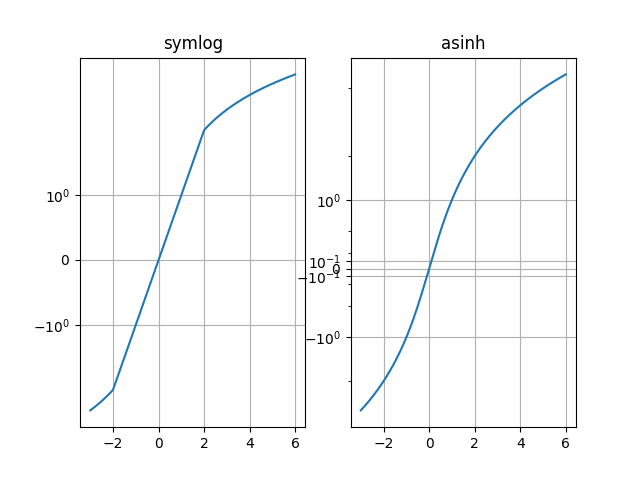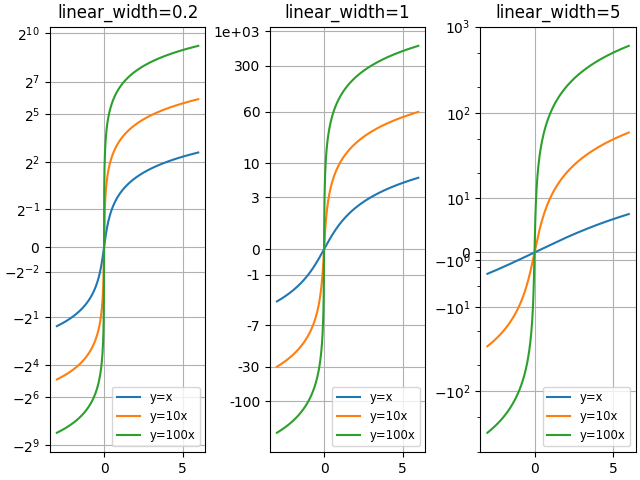笔记
单击此处 下载完整的示例代码
Asinh 演示#
asinh使用变换的轴缩放图示
\[a \rightarrow a_0 \sinh^{-1} (a / a_0)\]
对于接近零的坐标值(即远小于“线性宽度”\(a_0\)),这使值基本不变:
\[a \rightarrow a + \mathcal{O}(a^3)\]
但对于较大的值(即\(|a| \gg a_0\), 这是渐近的
\[a \rightarrow a_0 \, \mathrm{sgn}(a) \ln |a| + \mathcal{O}(1)\]
与symlog缩放一样,这允许绘制覆盖非常宽的动态范围的量,包括正值和负值。然而,symlog它涉及一个在其梯度中具有不连续性的变换,因为它是由单独的线性和对数变换构建的。缩放使用对所有(有限)值都平滑的asinh转换,这既在数学上更清晰,又减少了与绘图的线性和对数区域之间的突然转换相关的视觉伪影。
笔记
scale.AsinhScale是实验性的,API 可能会改变。
见AsinhScale,SymmetricalLogScale。
import numpy as np
import matplotlib.pyplot as plt
# Prepare sample values for variations on y=x graph:
x = np.linspace(-3, 6, 500)
比较样本 y=x 图上的 "symlog" 和 "asinh" 行为,其中在 y=2 附近的 "symlog" 中存在不连续梯度:
fig1 = plt.figure()
ax0, ax1 = fig1.subplots(1, 2, sharex=True)
ax0.plot(x, x)
ax0.set_yscale('symlog')
ax0.grid()
ax0.set_title('symlog')
ax1.plot(x, x)
ax1.set_yscale('asinh')
ax1.grid()
ax1.set_title('asinh')

Text(0.5, 1.0, 'asinh')
比较具有不同比例参数“linear_width”的“asinh”图:
fig2 = plt.figure(constrained_layout=True)
axs = fig2.subplots(1, 3, sharex=True)
for ax, (a0, base) in zip(axs, ((0.2, 2), (1.0, 0), (5.0, 10))):
ax.set_title('linear_width={:.3g}'.format(a0))
ax.plot(x, x, label='y=x')
ax.plot(x, 10*x, label='y=10x')
ax.plot(x, 100*x, label='y=100x')
ax.set_yscale('asinh', linear_width=a0, base=base)
ax.grid()
ax.legend(loc='best', fontsize='small')

比较 2D 柯西分布随机数上的“symlog”和“asinh”缩放,由于“symlog”中的梯度不连续性,人们可能会在 y=2 附近看到更细微的伪影:
fig3 = plt.figure()
ax = fig3.subplots(1, 1)
r = 3 * np.tan(np.random.uniform(-np.pi / 2.02, np.pi / 2.02,
size=(5000,)))
th = np.random.uniform(0, 2*np.pi, size=r.shape)
ax.scatter(r * np.cos(th), r * np.sin(th), s=4, alpha=0.5)
ax.set_xscale('asinh')
ax.set_yscale('symlog')
ax.set_xlabel('asinh')
ax.set_ylabel('symlog')
ax.set_title('2D Cauchy random deviates')
ax.set_xlim(-50, 50)
ax.set_ylim(-50, 50)
ax.grid()
plt.show()

脚本总运行时间:(0分2.229秒)